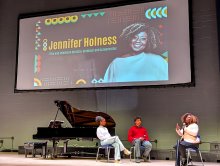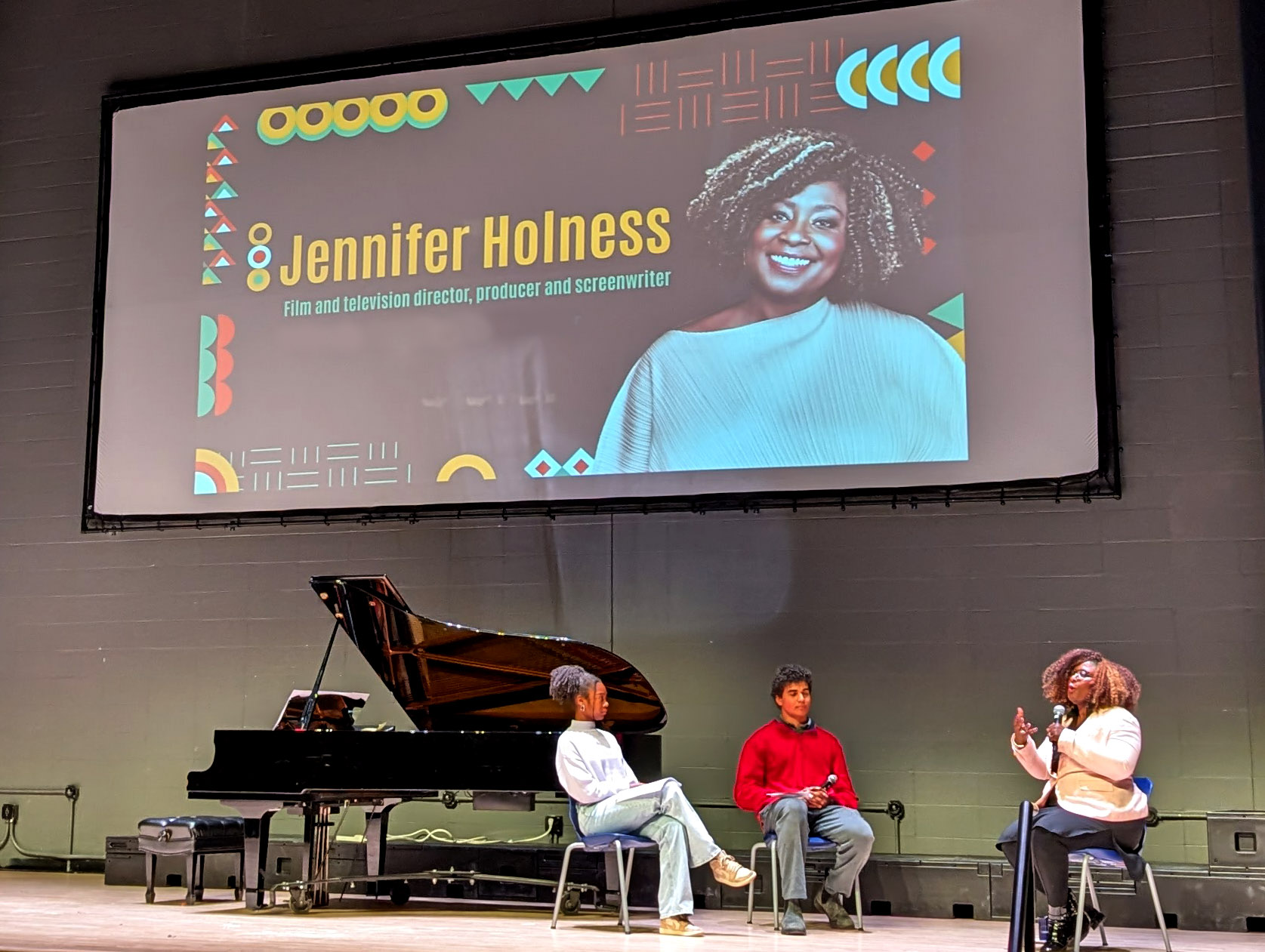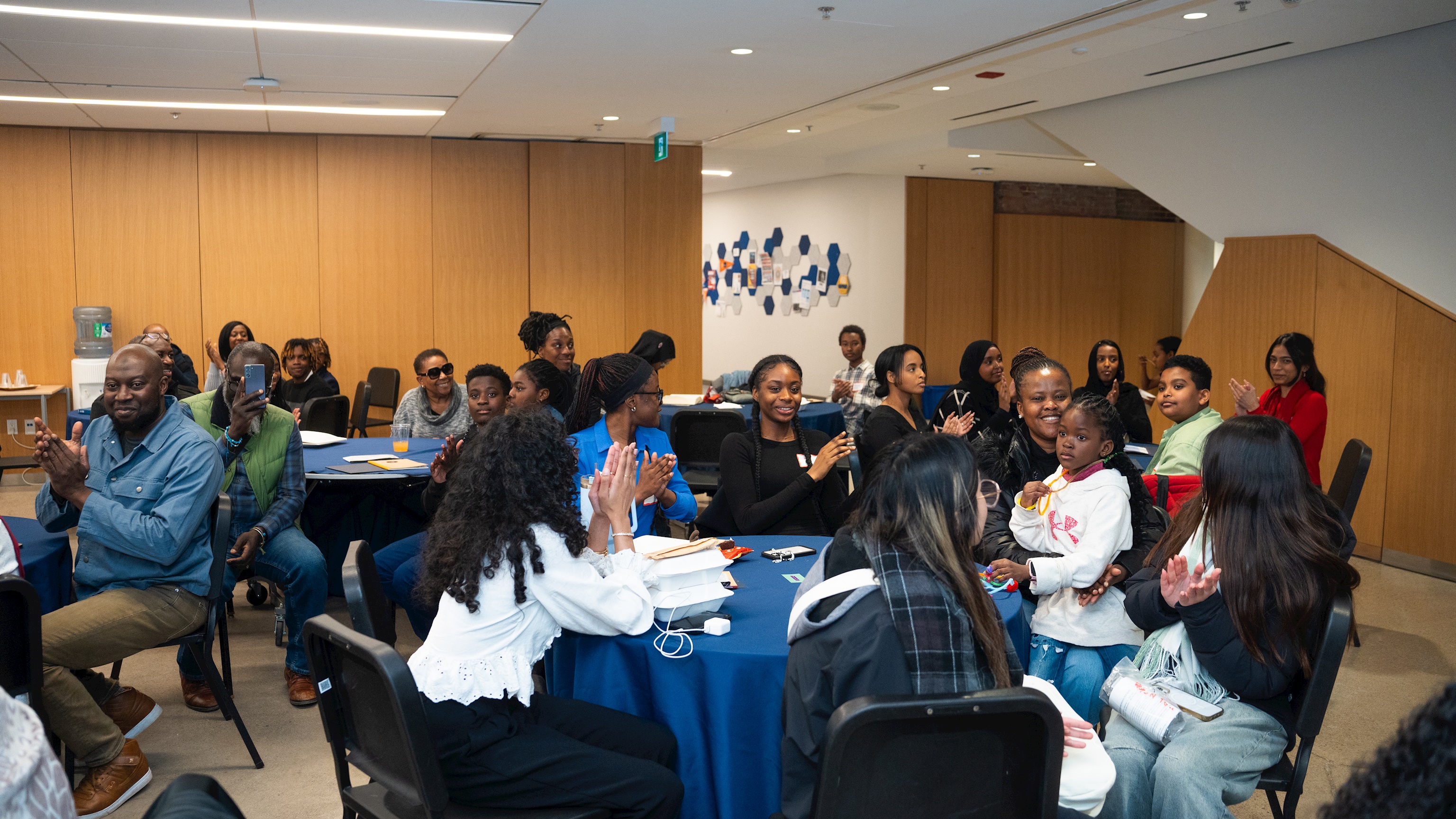371 Bloor Street West
Toronto, ON M5S 2R7 get directions
Toronto, ON M5S 2R7 get directions


Near the end of the UTS Black Futures Month Assembly in the Withrow Auditorium this February, the master of ceremonies S6 (grade 12) Georgio took the microphone to candidly share his personal experience at our school.
“When Zach and I enrolled at UTS in 2019 it was the second time in the school's history that there were two Black students in the same grade in almost 110 years,” he told the UTS school community. He and Zach had come from schools that were much more diverse, and weren’t used to being such a small minority and at times, experienced what he calls, “a cultural disconnect” with questions and comments about their food, hair and culture. “Experiences like these have their challenges,” he said, “at the end of the day, they're part of the richness of cultural exchange, and they contribute to what makes coming to UTS so valuable. While exchanging culture and experience is a beautiful thing, it is equally as important to have a community of people that you can relate to, because it can help dissuade the feelings of isolation that are bound to surface when a group is underrepresented.”
Hopeful for the future
While there were moments when he felt different from others at UTS, he said, “I'd be lying if I said I didn't feel welcome.” Over his time at UTS, more Black students and staff joined the school, and now UTS has about 20 Black students. “Although we're still a very small minority here, there's a much stronger community than there was when I first joined and I'm hopeful for the future of the Black community at UTS.”
His moving testimonial tied together an assembly that took our school community on a powerful journey towards a greater understanding of the Black experience, here at UTS and in Canada. Organized by student leaders on the UTS Black Equity Committee – S6s (grade 12s) Tyen, Cici, Zach, Shylah and Georgio, and S5s Diara, Eden and Max – the assembly also included a panel discussion with UTS parent, award-winning film television director, producer and screenwriter Jennifer Holness P '21, '25.
“In November, we began brainstorming plans ‒ we knew we wanted to do a full assembly,” said Tyen, “And we wanted it to be a celebration of Black Futures Month, and show different aspects of what Black culture means at UTS.”
Diara and Max led the panel with Jennifer, who runs the production company Hungry Eyes Media with her husband, Sudz Sutherland P ’21, ’25, specializing in telling stories that engage with social issues and representations of Black Canadians.
Diara and Max introduce Jennifer Holness P '21, '25.
A true Black history
Jennifer told students that when she was growing up, she was taught nothing about Black Canadian history in school and was “shocked” when, as an adult, she began to uncover aspects of Canadian Black history she had never heard of before for her work. They became the basis of the revered History Channel series BLK: An Origin Story, that she produced and directed.
“When you don't have information, you don't know what came before, when things have been erased,” she said, “people form misguided ideas about who people are and what their contribution is. For me, this production touched so many people and changed so many people's opinions and understanding about what Canada is – that’s one of the reasons why I do this work.”
Media can define our possibilities

Diara and Max lead the panel with keynote speaker Jennifer Holness P '21, '25.
Another reason is simply the power of the media. “I understood growing up that what I saw in the media was so powerfully ingrained in what I thought was possible,” she adds.
Reading and movies were how she got her understanding of what the world could be. That’s how the brain works, she says, seeing images and absorbing, making it very difficult to distinguish between what's factual and what's presented in front of us in television and media. See a stereotype often enough and one can come to believe it is real. As artists and creators, she said it is important to stand firm and make sure we do not perpetuate stereotypes, and instead create content that is more reflective of what is real and true.
Being open to understanding
Most importantly, it is our obligation to stand up for each other and be there for our fellow man, she told students, and that means speaking up against racist comments about Black, Indigenous and other racialized groups.
“Ultimately, life is much richer and much fuller when you are able to open yourself up to someone else with a different point of view and a different experience,” she told students. “And I think as a filmmaker, that's how I approach every project ‒ being open to someone's story that's not mine.”
Eye to eye with everyone in the room
M4 (grade 10) Ethan speaks about what Black Futures Month means to him.
Also in the assembly, seven of our younger Black students spoke about what Black Futures Month means for them, expressing the hope that in time we won’t need Black Futures Month because everyone will be equal. In the eloquent words of M4 (grade 10) Safeyyah, “Black Futures Month should be about looking directly at a future where Black people don't need to be lifted up to be seen, because we are already eye to eye with everybody in every room.” M4 (grade 10) Ethan said, “We must always remember that this rich story of the Black community continues to grow and we should honour those who fought to make a fair and just future for us and future generations.”
The assembly culminated with M3 (grade 9) Yeab and Director of Music Lyris Pat’s moving performance of Lift Every Voice and Sing, often referred to as the Black National Anthem, which filled the Withrow Auditorium with the sound of possibility and purpose.
Culture, food and Black Jeopardy!
Students play Black Jeopardy!, organized by the UTS Black Equity Committee
Other Black Futures Month events at UTS included opportunities to taste delicious foods from the Black diaspora and understand Black culture with film screenings and art exhibits.
The month ended up with a game of Black Jeopardy! From the Black boxer who refused to fight in the Vietnam War to the player with the most expensive signing in women’s soccer history to a Black scientist known as the “Father of the Blood Bank,” students tested their knowledge of Black history and culture in an exciting, highly competitive game. The answers: Who is Muhammed Ali, Naomi Girma, Charles Drew?
With four teams, it became standing-room only as more students joined in the game, which highlighted and celebrated the achievements of Black inventors, filmmakers and actors, musicians and athletes as well as important moments in Black history ‒ a wonderful way to wrap up Black Futures Month at UTS.
1834 Youth Debates
.jpeg)
Black youth who took part in the 1834 Youth Debates. Photos courtesy of Operation Black Vote Canada.
Also this month, UTS hosted the third annual 1834 Youth Debates, an initiative of Operation Black Vote Canada, in partnership with our school, that gives Black youth from grades 7 to 12 the opportunity to enhance their public speaking skills with a six-week online program culminating with a debate competition.
Over 16 youth and 100 community members attended the competition, which began with inspiring guest speakers: Paula Ajala Alexis, the engagement coordinator of Black youth initiatives at Kids Help Phone; Kathy McDonald, a trustee at the Peel District School Board; and Rob Davis, who was the first Black city councilor in the City of York, serving from 1991 to 1997, and then on the amalgamated Toronto City Council from 1997 to 2000.
“At Operation Black Vote Canada, we are committed to empowering the next generation of leaders by providing platforms that amplify their voices and perspectives,” said Velma Morgan, chair of the organization. “The 1834 Youth Debates showcased the remarkable talents and insights of young Black debaters from across Ontario. These debates not only highlighted the depth of knowledge and critical thinking among our youth but also underscored the importance of fostering leadership within the Black community.”

Over 100 people came out to the inspiring day of debate.
